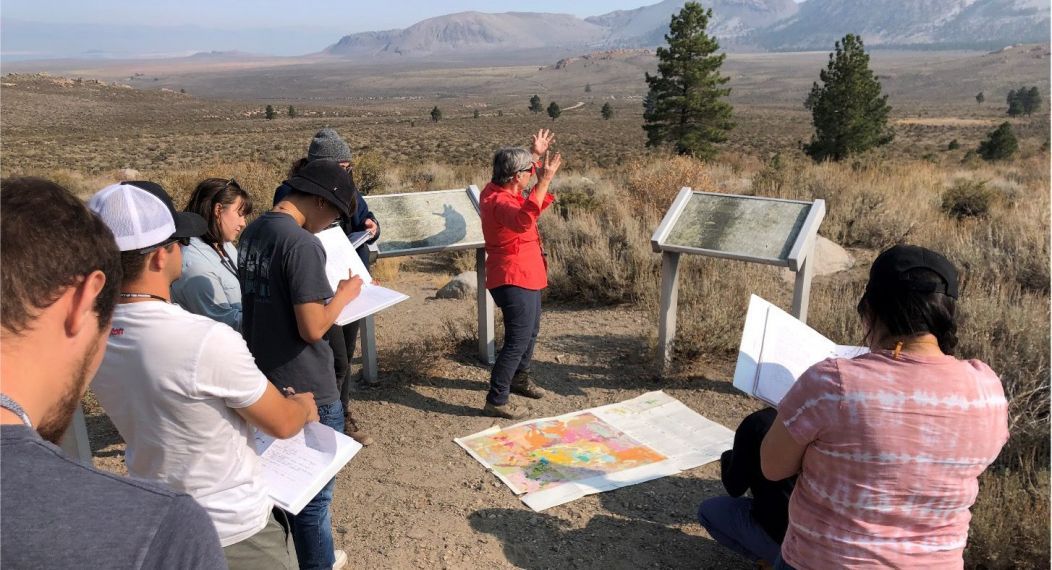Major: BS, Geological and Environmental Sciences
Graduation: May 2022
Hometown: Lodi, CA

Q: What do you think is unique about the geological and environmental sciences program at Pacific?
Jesse: While speaking to students from other universities, it seems that what's unique about our college and specifically our geology department is the small class sizes. Most of the classes range from about five to 20 students, so you get a more one-on-one experience with the professors.
Students who transferred to Pacific [from other schools] said they would have classes ranging from 50 to a couple hundred people at the entry level geology courses which didn't give you a lot of opportunity to discuss course material with professors.
Q: Is hands-on experience important for a geology major?
Jesse: Yes, so geology is a very hands-on profession. If you don't know how to identify things in the field, you won't be very successful in a professional career. And that ties back to the small class size.
If you think about having a class of 50 to a couple hundred people, it's very difficult to get all those students out on a field experience and keep it organized. That's the selling point for our department. With the small class sizes, we can load up in a couple of vehicles and go on one-day or multiple-day trips and still be able to see a lot of the different geological outcroppings and formations for any given class.
Q: What types of hands-on learning experiences have you had at Pacific?
Jesse: Most of my experiences have been field trips. One of the big trips we took was through our structure course which is looking at structural changes and formations as they go below the earth's surface and kind of the processes that lead to those changes and mechanisms.
During that trip, we were out in the desert mapping and looking at outcrops. With the smaller class size, we were able to go to way more remote locations safely, taking samples and mapping angles and taking strikes and dips, which is like the measurement of how the formations go down into the earth, so that you can make a report later.
That is very important for the professional field, because that ties into things like oil geology and mining geology where you're looking at where your oil traps are below the surface and where your mineral deposits are going to be.
Just being able to go out in the field in the small groups and have a continued conversation with a professor as you walk through, I think is very beneficial for students, especially in very hands-on mapping professions of mineral and oil geology.
Q: What's the follow up from a field trip when you come back to classes on campus?
Jesse: So the latter half is often an analysis of what you saw in the field, because the geology that we often see isn't very cut and dry, you have to work at it like a puzzle because you'll have one magma body coming up here and another going over there, and whatever is in between could be metamorphic, could be eroded, you don't know until you've gone through and looked at the entire area taking notes and samples and looked at maps. Then you're able to just start to piece together what you're looking at.
In the field you're making interpretations, once you're actually back in the classroom you have time to go over all your data and piece together what you were actually looking at in the field.
Q: Do you collaborate with other students and your professor?
Jesse: It depends on what the assignment requires, but in the geology department we're very collaborative because that's professionally what you're going to be doing. The problem with doing this kind of work on your own is the interpretations that you're making are fairly subjective because a certain crack in the rock could be interpreted a dozen different ways. So being able to collaborate with your fellow students and professors on data really allows for a better picture to be formed rather than what you might find just on your own.
Q: Does the location of Pacific contribute to a more robust experience for geology students?
Jesse: The great thing about studying here in California is the unique experience of being in a state where we have the Sierra Nevadas which is unique in that it creates multiple zones of geology that you can see.
You have three categories of rocks that we mostly study which are sedimentary, metamorphic and igneous. Moving from the coast, you have the sediments, halfway towards the Sierra Nevadas you have a lot of metamorphic. As you move into the Sierra Nevada, you see the igneous rock deposits. In a state like Oregon, pretty much all you're going to see is volcanic flows whereas here in California you're able to study all three in a fairly small, confined area.
Q: In general, what kind of people are geologists?
Jesse: I would say that geologists in general are very outdoorsy people given that much of what you do both in school and in the workforce is field work so, that really draws people who are hikers or rock climbers, people that really enjoy the outdoors. You also get a very inclusive feel from the group.




